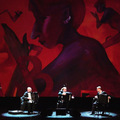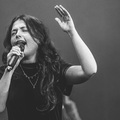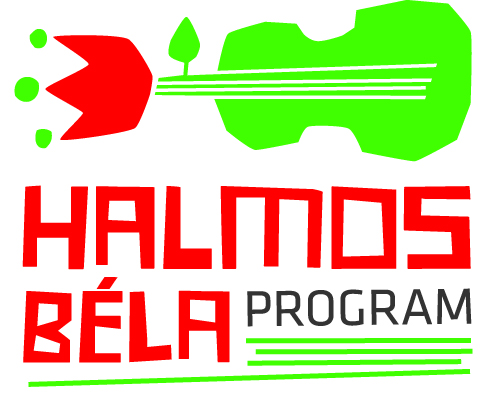Vlatko Stefanovski, Macedonian guitarist, is a true giant of the Balkan music world. Throughout his 50-years long career, he has played in many different formations and bands, as well as in many different styles and genres. But one thing he never leaves behind: the folk music and traditional melodies of his homeland, which is a recurring feature in his music. He will play in the grand hall of the Liszt Academy of Music in Budapest with his long-time partner, Miroslav Tadic. The concert will be streamed online as part of the 3. Budapest International Guitar Festival and Competition.
As far as I know this is the first interview that you give to a Hungarian journalist, despite having played in the country many times before. In this case I really would like to talk a little bit about your first success with your first band Leb i Sol that played a huge part in the history of yugoslavian rock scene. The music the band played is often labeled as ethno-rock. What do you think about this term now?
At the time when we started in the mid-seventies, that term was not in use. Ethno was not in use as a subdivision in music, and until now I am not very happy with that word. It doesn't mean anything. I would rather use the term world music, or music of the world or if I want to somehow label what we were doing at that time I would say we were a progressive rock fusion band, something like that. Because we used many elements from many different genres of music. We improvised a lot, we used the irregular rhythms from the Balkan heritage, from the Balkan traditional music. So we were also playing with those irregular rhythms, we were combining ⅞, 9/8, 11/8. We were just playing with what we had around us. And it was always traditional music, it was always present in the radios. It was like a local tradition and a very familiar music. It was not very difficult for us to learn some tunes and melodies and rhythms from that music. And we were also playing very loud, like a hard rock band in one way. We were improvising a lot of fusion jazz and if you want to name it ethno, you can name it ethno, sure. But ethno is not the right word, ethno rather means folklore music, like folk music. But what we tried to do was to amplify that to make it modern, to electrify the tradition somehow. I think we were quite successful in experimenting and trying to put all these influences together. I personally listened to progressive rock or sympho rock from the early seventies, like Yes, Focus, some fusion jazz groups like Return to Forever and Mahavishnu Orchestra. It was all combined. I was under the great influence of that kind of music.

You were pretty successful and found your audience, but I was wondering how open the industry was for this new approach? Was it easy for you to get record deals and play concerts at the beginning?
Yes, we gained popularity pretty fast. We signed a contract to do our first album when we were all around our early twenties. I was twenty years old when we signed our first record deal with PGP-RTB, the main record label. So we were pretty well accepted. It was kind of a fresh, new offer in the mainstream pop and rock music of that time. We had many popular groups, but we were the only band that was going that far in the arrangements and we were pretty original. We were using this folklore in a very creative way, I would say. We could take a main theme from one popular song and we would do an interesting arrangement or interesting approach to those things. On the other hand, I was writing vocal songs too, more straight rock, pop music. So on our albums we could have two or three traditional folk themes and the rest was our compositions that had nothing to do with folklore. So that was a nice interesting mixture. We were radio friendly with all these vocal songs and on the concerts we were doing all different stuff. And people liked it.
How common was it in your childhood or just in general at that time for people in the sixties, seventies to hear these folk tunes?
Well that was the same as going to the park or going to school or going to kindergarten. It was a normal thing to listen to some folk music around. Television, radios, wedding parties - it was all played like the soundtrack of our young life. We were surrounded by folklore, but we didn’t take it seriously to be honest. My generation wanted to listen to rock music and pop music coming from the west. So our folklore at that time was not very popular among youngsters, it was popular among our parents. It was not our music, it was present but we didn’t show any big interest in playing folklore, which means it was some kind of passé for the young generation. We started to use these elements, because we found something interesting in that music, something very inspiring. So we tried to combine our new fashion, rock and roll with electronic instruments with this old school folk. And I think that formula that we used was pretty successful somehow. People liked it very much. So we became popular pretty fast.
I asked this because you have been playing in different formations ever since but the folk music, folk melodies seem to be one of the elements that is always constant, that is always recurring in most of the things you do.
I lean on these themes quite heavily, because I find that this music is very good for improvising, for doing some variations. You can go pretty far. We can go pretty far using this music, because of the rhythms ⅞, 9/8. These are hypnotic rhythms. They differ pretty much from the normal 4/4 measures you find in pop and rock music. Look, in the seventies many groups tried to be original somehow, so one of the ways for us to try to be original was to use something that was pretty unknown in the rock scene. It was pretty new and fresh I would say, although many people were influenced by different music. Like the Beatles were inspired by Indian music, some other bands by African, Pakistani music. But it’s good to make the meal from ingredients that you have around you. You know we have this folklore around us, so we used this with not too much thinking.
You just said these rhythmic patterns are hypnotic. What do you think makes these hypnotic? If someone says hypnotic music I think many people would think about music based on the 4/4 rhythmic pattern.
I don't know, it is different than the 4/4 measures, because if you count ⅞, 9/8 or 11/8 you get into a loop. If you ask me I am not very crazy about the modern techno rhythms and beats. It is hypnotic but it is nothing like traditional folklore music. It's attacking you more physically than emotionally, but these rhythms have some magic inside of them, because they are not linear somehow. If you count 1-2-3, 1-2, 1-2, 1-2-3, 1-2, 1-2. It’s different from 1-2-3-4, 1-2-3-4. It is different because it is a kind of asymmetrical rhythm, and it hits you in a different way than a 4/4 beat. And those rhythms are also covered by dances. Those dances are hypnotical, too. If you watch those folklore ensembles from Macedonia or from the Balkans, oh they are amazing ensembles. Like the Macedonian Tanec Ensemble. I have performed with them. They are amazing, if you look at them you catch the hypnosis. Also there are rubato rhythms in Macedonian music. Our first big hit with Leb i Sol was Aber Dojde Donke from our second album, but it was recorded even before our first album. That was a shock, because it was a rubato, so there were no obvious rhythms, there was plenty of rhythm but in a way you couldn’t count it. So there are things you cannot count you can just feel. You cannot count some rhythm, you have to feel them before you play them.
You also described in that interview that today's world is one of endless transitions, which I found very touching and true. Do you think folk music serves as a stable entity in this endless transition?
Look, it is a reflection of our lives. Music is always a reflection of our lives somehow. And of course this region is very unstable and there has always been political instability. And it has always been like that, it has always been in the air somehow, it reflects the culture, the art, the everyday life of the people who live here in the region. It has been like that for centuries. So you can find some big blues in the melodies and in the music of these people around. Lots of blues. What is blues? When the good man suffers - it is the blues. A lot of struggling, poverty, and everything that goes with it is reflected in art and literature and poetry and also folklore. So that's what we do, we play the blues in our own way.
Yes, we do the same in Hungary. Hungarian folk music is also in many ways about that, more about the struggles, very few times about the joy, most of the time about the struggles.
I would say it is more about struggles than about joy. Probably joy is about 30%, struggle is about 70% in all the poetry and folklore, as well. Many people are influenced by your great composer Béla Bartók who did that, too. Frank Zappa was influenced by him, too. I also have some records by him. He was an amazing composer. Also, he was influenced by folklore, if I know well. By some Balkan music, Turkish music.
Yes, he travelled a lot, and recorded those people who were in their seventies, eighties in the early 20th century and saved these old songs for us.
Yes.

The Balkans, South Slavic countries in many ways seem to be so similar but in many ways so distant culturally. How much do you view Macedonian music as a heritage of a certain place or how much do you think about it as a heritage of this wider region?
There are some phrases and songs that are in common. There are many similarities between these different cultures in the Balkans. If you see wedding parties for example, the music you can hear there also shares many characteristics. Since I live here, I have mostly been interested in what is around me. Of course I played with Theodosii Spassov who is a great artist from Bulgaria. We have also found some similarities between Macedonian and Bulgarian music, and I also played with Greek, Croatian, Serbian, Bosnian musicians. So we have many things to share, many things in common. On the other side we can teach each other some things that we don’t know from other cultures. The quality is in exchange. If you teach something they don’t know, they teach you something you don’t know. That is the beauty of playing with musicians with different cultures. The beauty is in exchanging knowledge and sharing the stage, sharing the studio with some big talents. That is the beauty of music production.
And you are going to share the stage with Miroslav Tadic for the concert in Budapest. You have been playing together for quite a long time. And your cooperation is definitely one of the best examples of the cultural exchange that you were talking about.
Yes, he has lived in Los Angeles for thirty years. He is a very interesting case. He was born in Bosnia, but his father was Serbian, his mother was Croatian but he lives in the United States. It is a unique cultural tradition somehow. He is surrounded by everything from rock, pop music to jazz and blues. But on the other hand he has never left his influences and his heritage from the Balkan. He has never left that. He is always enthusiastic to learn some new stuff from Macedonian music, South-American music, Spanish music. He is a professor of music who knows a lot. He knows music theory, he is fond of blues, flamengo, Brazilian music, and he knows a lot about Balkan music. It is a big pleasure and fun for me to play with him, because he is theoretically educated very well, he can combine all the possible harmonies and melodies. We share something that I call cognitive resonance. We can play without watching each other, with our eyes closed, because we have developed some antennas, radars that work without us somehow. We understand each other without talking too much, we play together without talking too much, planning too much.
Tickets for the online event can be purchased at the website of the festival.
A bejegyzés trackback címe:
Kommentek:
A hozzászólások a vonatkozó jogszabályok értelmében felhasználói tartalomnak minősülnek, értük a szolgáltatás technikai üzemeltetője semmilyen felelősséget nem vállal, azokat nem ellenőrzi. Kifogás esetén forduljon a blog szerkesztőjéhez. Részletek a Felhasználási feltételekben és az adatvédelmi tájékoztatóban.



